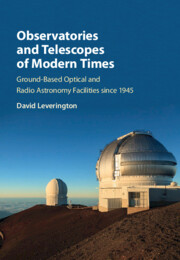 Observatories and Telescopes of Modern Times
Observatories and Telescopes of Modern Times from Part 1 - Optical Observatories
Published online by Cambridge University Press: 15 December 2016
Introduction
Although the Palomar Observatory had been very successful after the completion of its main instruments in the late 1940s, its existence had only exacerbated an underlying problem in the organisation of astronomy in the United States. This was because at that time the vast majority of telescopes were already owned by a limited number of prestigious universities or observatories. These had been paid for by private benefactors and their use had been generally limited to members of these institutions. As a result, astronomers at less wealthy universities had only access to instruments of more limited performance. There was no tradition of publicly funded observatories in the United States at that time, unlike that of many European countries.
The first major collaboration between two American universities in the provision of an optical observatory was instituted in 1932, when it was agreed that the new McDonald Observatory would be the joint responsibility of the universities of Texas and Chicago. Then in 1940 Otto Struve, McDonald's director, published an article ‘Cooperation in Astronomy’ in Scientific Monthly.(1) In this, he suggested setting up a collaborative observatory between a larger number of astronomical institutions. This would have provided the wider access required, although Struve was assuming, at the time, that the initial finance would be provided by a private benefactor, in this case either the Carnegie Institution or the Rockefeller Foundation. Unfortunately, this project had to be put on hold at the time because of the imminent involvement of the United States in the Second World War.
The Second World War saw a turning point in the funding of technology in general by the United States government. In both the United States and Europe large sums of money were spent on nuclear, radio and radar research, and in Germany, in particular, on the development of rockets like the V2. All of this was to have a major effect on the development of astronomy in the United States and elsewhere after the war. In the United States, in particular, it also had the effect of generating much more centralised government funding for all types of scientific research, both civil and military.
To save this book to your Kindle, first ensure [email protected] is added to your Approved Personal Document E-mail List under your Personal Document Settings on the Manage Your Content and Devices page of your Amazon account. Then enter the ‘name’ part of your Kindle email address below. Find out more about saving to your Kindle.
Note you can select to save to either the @free.kindle.com or @kindle.com variations. ‘@free.kindle.com’ emails are free but can only be saved to your device when it is connected to wi-fi. ‘@kindle.com’ emails can be delivered even when you are not connected to wi-fi, but note that service fees apply.
Find out more about the Kindle Personal Document Service.
To save content items to your account, please confirm that you agree to abide by our usage policies. If this is the first time you use this feature, you will be asked to authorise Cambridge Core to connect with your account. Find out more about saving content to Dropbox.
To save content items to your account, please confirm that you agree to abide by our usage policies. If this is the first time you use this feature, you will be asked to authorise Cambridge Core to connect with your account. Find out more about saving content to Google Drive.